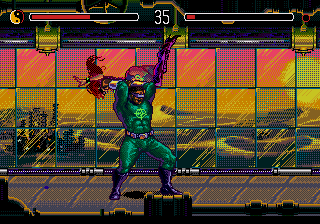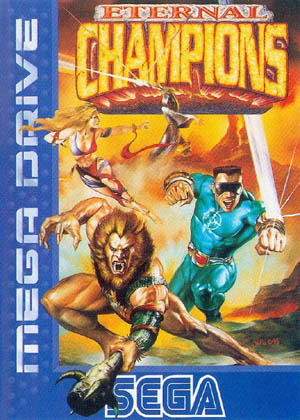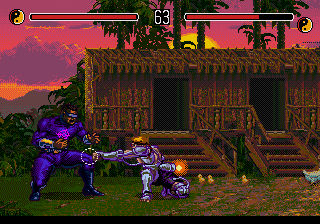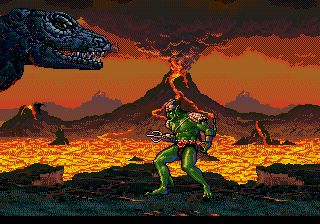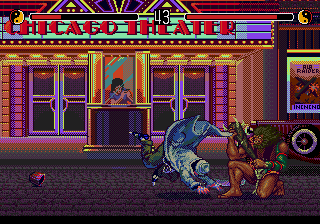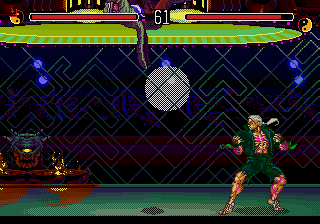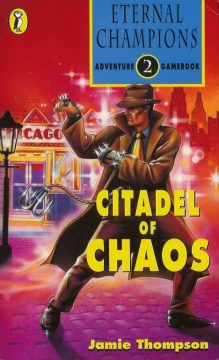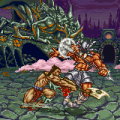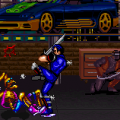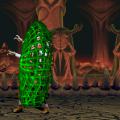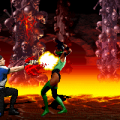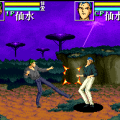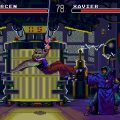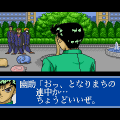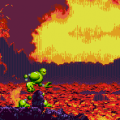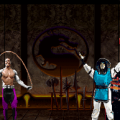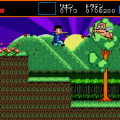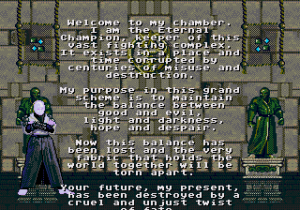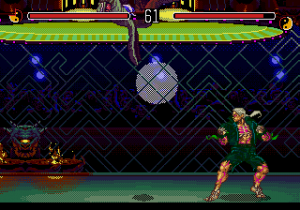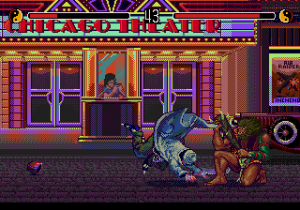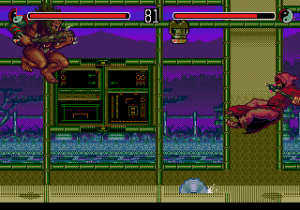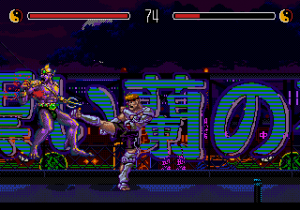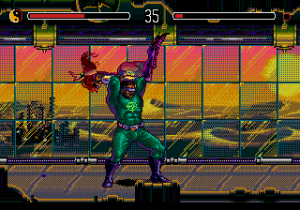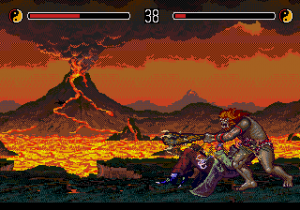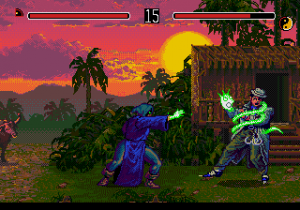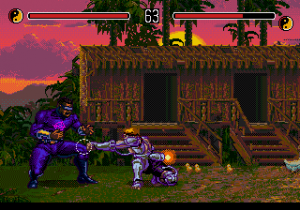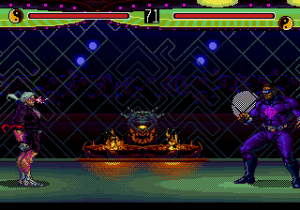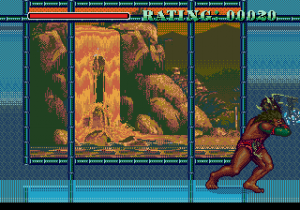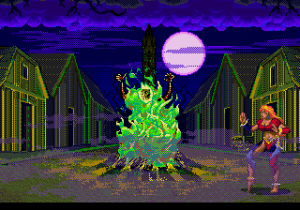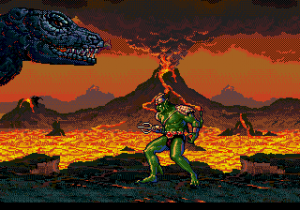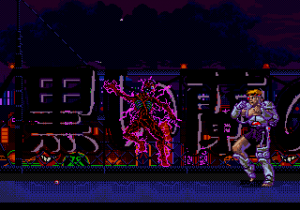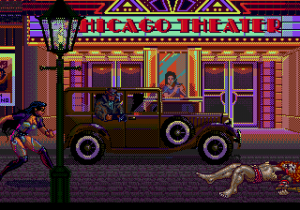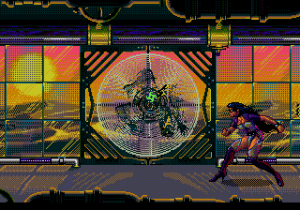- Eternal Champions
- Eternal Champions: Challenge From The Dark Side
Street Fighter II and Mortal Kombat were, as you probably don’t even need to be told, both incredibly huge hits. Street Fighter II had speed, a cast of interesting characters, and a high level of technical skill under the surface. While Mortal Kombat didn’t have as high a skill level, it made up for it in blood and brutality. Before Sega released their flagship fighter, Virtua Fighter, they came up with a plan for a fighting game of their own. A game that would mix the flair and style of Mortal Kombat with the gameplay of Street Fighter. Did it work? Well – not really. Their first mistake, instead of putting such talent as Yu Suzuki or Yuji Naka to the task, was hiring the guys who made Dinosaurs For Hire.
Of course, that’s not to say the series was all bad. There are some neat ideas in there, some that might have been the first real use of them in any fighting game up to that point, however, there are just so many flaws and issues that the series will be doomed to be cursed along with Kasumi Ninja and Bloodstorm, which it doesn’t ENTIRELY deserve.
Far, far into the future, mankind has ended up destroying itself. The cause of this is the untimely demise of a certain nine individuals throughout history, who would have done something to change the flow of time for the better if it weren’t for their death. The good news is that an alien creature, known as the Eternal Champion, has the power to bring people back from the dead. The bad news is he can only do it once. So, instead of, say, hosting an organized debate on who should come back to life, he just has them all beat each other up. The one who defeats all the fighters, and the Eternal Champion, gets to return to the moment before their death, while everybody else just dies again.
The game actually puts a lot more effort into its plot than pretty much any other fighting game of the era. There’s even a biography mode, which gives information on the characters, their histories and their fighting styles. None of it is actually used in the game itself, but it’s a neat idea, anyway.
There’s nine different characters to play as, not counting the Eternal Champion, who’s unplayable.
Characters
Shadow Yamoto
A female ninja who uses (surprisingly) Ninjitsu as her fighting style. Formerly a corporate assassin, she had a change of heart and was pushed off of a skyscraper by her employers for it. She uses many ninja weapons and techniques, including several projectiles like knives, shurikens, and smoke bombs. The closest thing to a main character in the series, she ended up getting a game of her own called X-Perts. It was terrible.
Trident
An Atlantean gladiator and some kind of fish man who uses Capoeira. How the ancient Atlanteans learned Capoeira, which originated in Brazil, I don’t know. Trident ended up getting killed in a rigged fight with a Roman gladiator, which led to his society being trapped undersea forever. Trident, so named for the hook he has for one of his hands, is one of the cheapest characters in the game with the sheer amount of moves he has that stuns opponents.
Jetta Max
A circus performer who uses a mix of Savate and Pencak Silat. She had her circus act staged to attempt to bring peace to China, sabotaged by rebels, which ended up killing her from the fall. As one of the game’s faster characters, she can roll into a ball, Blanka-style, as well as make herself vibrate, which somehow causes her to move even faster.
Xavier Pendragon
An alchemist who uses Hapkido Cane Fighting. He was burned at the stake due to the fact that his powers, based on science, were actually dark magic. To be fair, they had a point, since this guy can shoot a magic dragon out of his staff which can bite people, along with turning them to gold, and, in one of the weirdest moves in fighting game history, swap characters with his opponent.
Midknight
A vampire who uses Jeet Kune Do. Formerly a scientist commissioned to create a biochemical weapon to end the Vietnam War, he ended up falling into a vat of his own formula after having a change of heart. The mixture somehow turned him into a vampire, with hypnotism powers and all. Then he ended up getting staked by a government agent 133 years later.
R.A.X. Coswell
A cyborg Muay Thai kickboxer. Ended up killed by a virus implanted by his manager, who bet on another fighter. He plans to return kickboxing to its human roots if he wins the tournament. Aside from his kickboxing moves, he can use his cybernetic enhancements to fly across the screen and shoot lasers from his eyes. Why he wants an end to that, I don’t know.
Jonathan Blade
A bounty hunter who uses Kempo. He was sent by the government to capture a rogue scientist, who carried a virus that would kill 99% of the world’s population. Before he could negotiate a peaceful solution with the scientist, the government killed him, causing the vial to shatter across the ground… So, you think that the guy who would save the entire world from dying would get priority over everybody else, but apparently not.
Larcen Tyler
A cat burglar working for the mob, who uses Mantis Style Kung Fu. He was sent to deliver a package to the chief of police, however, it turned out the package had a bomb inside it, and Larcen ended up blowing himself up as well. He comes with a set of tools he uses in combat, like a grappling hook and a pair of spiked knuckles, that let him crawl across the ceiling. He also got his own game for the Game Gear called Chicago Syndicate. It too was terrible. Honestly, he is probably the best character in the game, since he’s basically a mutant blender mix of a 1920s gangster, Vega, and Batman.
Slash
A caveman who uses… well, it’s not technically a fighting style, but the game calls it Pain. He uses a big club, which he can use to bat away projectiles along with smacking opponents around. He was stoned to death by other cavemen because they didn’t like his ideas. To be honest, compared to the vampire, Slash is just boring. Also, if he’s carrying a blunt object, why is he called Slash?
The character designs are decent, and while they’re a little lacking in personality, one nice touch is that the characters actually perform a small animation at the beginning of each fight. This probably wasn’t the first fighting game to feature this, but it was so early in the genre, it’s probably close. One issue with the game is that there are pretty much no “archetypes” at all, compared to games like Street Fighter. There’s no “grappler” “shoto” or “charge character” you can rely on, since everybody plays so wildly different. On one hand, it’s nice they used a little bit of originality; on the other hand, it does make the game hard to pick up and play.
The game takes more after Street Fighter than Mortal Kombat, both in gameplay and art style. You have your standard six-button layout with three buttons for punches and three for kicks, unless you’re using a three-button controller, which means you have to press Start to switch between punches or kicks, and you really do not want that. The game controls well enough, and each character’s basic moves are diverse enough – compared to Mortal Kombat, where everybody shared the same standard move set.
Instead of doing the sensible option and using Street Fighter‘s special move inputs, every special move in the game is either a charge motion or involves hitting multiple buttons at the same time. While the charge motions aren’t hard to pull off, it’s extremely difficult to hit all three punches or all three kicks on a standard Genesis controller without maneuvering your hand in an awkward way. Of course, that’s if you can even do your special moves, thanks to an odd system this game introduces.
Every character has a yin-yang symbol next to their life bar, split into four quarters. This represents their “inner Strength” and performing special moves costs some inner strength. If you don’t have enough for the move, you’re just going to have to wait for it to recharge. This is a nice idea on paper, since it’s basically there to stop fireball spammers. But the problem is, it takes way too long for your inner strength to recharge. You can also taunt to take away your opponent’s inner strength, with some cost to your own as well. The AI loves to do this, leaving you mostly powerless.
The special moves also work really oddly compared to the standard throws, fireballs, and dragon punch-style moves that were in so many other fighting games at the time. While every character has at least a few special moves that deal direct damage, others reflect projectiles, screw with the opponent’s controls, buff themselves so they’re more resistant to damage, debuff the opponent so they deal LESS damage, leech away health from the opponent, and swap the character you’re playing as entirely. At least they were trying to be original. However, this makes it hard to pick up the game compared to other fighters, where you can simply choose whoever the cursor starts on and go from there.
Compared to Mortal Kombat, Eternal Champions is pretty subdued as far as blood goes. The only time you actually see any is when somebody is close to being dizzied. There’s also no fatalities in the traditional sense, although there is one kind of finishing move that the game dubs, “overkills”.
Overkills are performed by knocking an opponent onto a certain part of the stage with your final hit on the winning round. If you do it right, some part of the background will end up finishing them off, like getting knocked into a giant fan, or getting mowed down by mobsters. These are much more stylish than bloody, with only one Overkill actually involving blood at all, but some of them are actually quite brutal. The problem, though, is the spot you have to knock the opponent into is so precise that it’s basically a one in a million chance you’ll ever see them if you’re not actively trying to do one.
While the two player mode can be fun if you manage to get a hold on how the characters play, the single player mode is so frustrating that it’s not worth the effort at all. For one thing, the AI starts off completely unfair and only goes up from there, being able to counter everything you do until you find some way to exploit it. If you lose a match in single player mode, instead of getting sent to a continue screen like, say, every fighter ever made, you get sent back TWO matches away from the person who beat you. And if you somehow manage to find a way to exploit every single AI character, then you get to fight the Eternal Champion.
The Eternal Champion is, without a doubt, one of the cheapest bosses in fighting game history. Igniz, Geese, Seth, they’ve got nothing on this guy. For one thing, he has infinite inner strength, which means he can spam his moves as much as he wants, as well as suck as much strength out of you as he needs by taunting. Secondly, he has FIVE different forms, and you must beat all of them in one round. You do get health back between each form, but if you ever lose the match against him, you get a bad ending and get kicked right back to the main menu. At least Final Bison from Alpha 3 had the decency to go down the same way as everybody else. If you manage to beat him, all you get is a text scroll explaining what your character went on to do.
Besides the standard arcade mode, there are quite a few others, much more than in Street Fighter II. Practice mode lets you play a single match against the CPU or another player, while letting you tweak the options. You can set the time limit, number of rounds, how much damage characters do, speed setting, as well as if you want inner strength on or not. The Battle Room is a special arena where you can pick and choose different hazards that appear in the stage, like buzzsaws that go across the ground or energy bolts that drain your inner strength.
There’s also a training mode, quite possibly the first of its kind in any fighting game. Dexterity Spheres is a minigame where you have to hit as many floating spheres as you can before they knock you out. Holo-Trainer is where you try to score as many points as you can on a holographic CPU opponent before you end up losing all your health. And Training Sphere is basically a big, stationary sphere that you can hit to get a feel for your basic moves. Sadly, there’s no mode for having a dummy opponent that you can properly practice moves and combos on. Still, the idea is nice.
While the gameplay’s not quite fantastic, the presentation is pretty slick. The character sprites are huge, about twice the size of the sprites in the Genesis port for SF2. They’re all heavily shaded, giving them a comic book-esque appearance, which fits well with the game’s pulpy style. The animation, however, is a little inconsistent in quality. While some animations are quite smooth, the fact that characters only react to damage in one way is a little cheap looking.
The stages are also pretty nice to look at, with each character having a stage based on their own time period. It is kind of weird that a circus performer would fight in what appears to be a Chinese temple, however. Blade’s stage is particularly impressive, the sunset in the background making good use of the Genesis’s limited palette. There’s also a nice touch where each time you boot the game up, a different character will do something to destroy the Sega logo… There’s something rather poetic about a vampire slowly sucking the life out of Sega, really.
The sound, however, pales in comparison to the nice graphics. The music uses the same sort of sound hardware as pretty much every US-developed Genesis game, making everything sound loud and sort of screechy. The characters don’t grunt or yell like most other fighting game characters, but each has a voice clip they use when they taunt, like “junk!” or “coward!” At least the speech is moderately clear for a Genesis game.
Overall, Eternal Champions isn’t really the best fighting game on the Genesis, especially since good ports of the games it was inspired by are so readily available. It does try to do its own thing, and that’s quite respectable. The problem is when it does, it doesn’t always end up working out. Still, this wouldn’t quite be the end of the series. Besides the Genesis version, the game was also eventually released for the Wii’s virtual console. Apparently there were plans for it to be in some of Sega’s Genesis compilations, but it never was, apparently because it would have bumped up the rating too high.
Developer Interviews:
Interview with Michael Latham – by Sega-16, this talks with the main man behind Eternal Champions, and is essential reading for any anyone interested in the series.
Interview with Steven Lashower – another interview by Sega-16, this looks at the publicity surrounding Eternal Champions and also its bundling with the Activator peripheral.
Interview with Scott Berfield – again by Sega-16, this talks with the man behind the original concept of Eternal Champions and some of its character designs. His candid answers about the final and rather different product may surprise you!
Gamebooks and Comics (1994)
Besides the video games, for whatever reason, somebody decided to make Eternal Champions gamebooks. A gamebook, if you’ve never played one, is more or less a Choose Your Own Adventure with the addition of RPG elements, like stats and inventories. Two books exist, The Cyber Warriors and Citadel of Chaos.
In The Cyber Warriors, all the original nine characters got restored to their original times, somehow. Somewhere in the far future, a rogue AI known as Overlord has plans to replace the fighters with androids so they can never fulfill their original destiny. You, as the newest champion, are sent out to destroy the androids and the factory where they’re being made. In Citadel of Chaos, you bring the other nine with you to the Overlord’s fortress in order to destroy him once and for all.
You start by creating a character, done by writing down his stats and then adding three points to the ones you want. You also get three “Special Moves” which increase your attack power, increase your defense, or heal you, at the cost of one of your Inner Strength points.
Fights are handled by picking the attack you want to perform, turning to that paragraph, and then rolling a six-sided die to see if you can beat your opponent’s defence. Defending is done the same way, as well as rolling for performing certain actions, such as pushing Larcen out of the way of an attacker.
Overall, if you enjoyed gamebooks like Fighting Fantasy and Lone Wolf, and you’re so much of a huge fan of the series you must have every piece of merchandising attached to it, you might as well look for a PDF. It’s not entirely unfair, there’s a good bit of non-linearity, and it’s nice to see the characters have some sense of a personality. Further information on the Game Books, also where we got the cover images.
There was also a long-ish running series of comics, found in the old Sonic the Comic, with several special edition issues dedicated to Eternal Champions. More information can be found on the Sonic the Comic Wiki, while other info and plenty of scans are available on the 4th letter blog, though he seems to miss out a couple of special edition issues.
